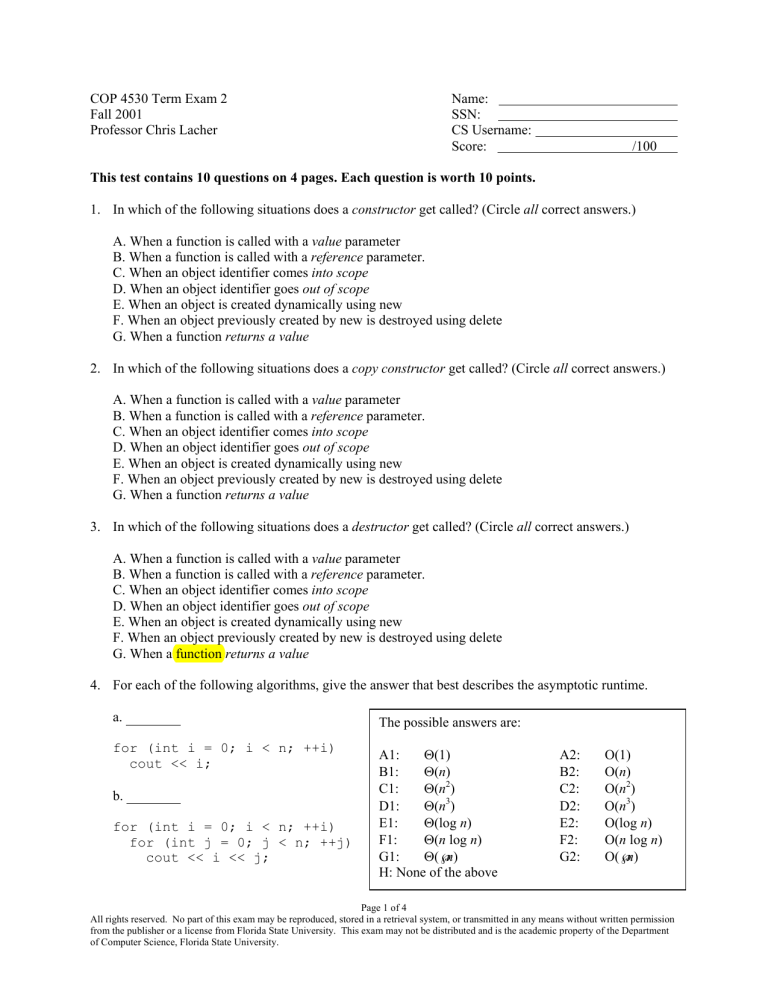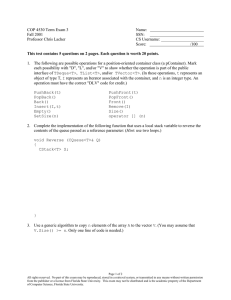
COP 4530 Term Exam 2
Fall 2001
Professor Chris Lacher
Name:
SSN:
CS Username:
Score:
/100
This test contains 10 questions on 4 pages. Each question is worth 10 points.
1. In which of the following situations does a constructor get called? (Circle all correct answers.)
A. When a function is called with a value parameter
B. When a function is called with a reference parameter.
C. When an object identifier comes into scope
D. When an object identifier goes out of scope
E. When an object is created dynamically using new
F. When an object previously created by new is destroyed using delete
G. When a function returns a value
2. In which of the following situations does a copy constructor get called? (Circle all correct answers.)
A. When a function is called with a value parameter
B. When a function is called with a reference parameter.
C. When an object identifier comes into scope
D. When an object identifier goes out of scope
E. When an object is created dynamically using new
F. When an object previously created by new is destroyed using delete
G. When a function returns a value
3. In which of the following situations does a destructor get called? (Circle all correct answers.)
A. When a function is called with a value parameter
B. When a function is called with a reference parameter.
C. When an object identifier comes into scope
D. When an object identifier goes out of scope
E. When an object is created dynamically using new
F. When an object previously created by new is destroyed using delete
G. When a function returns a value
4. For each of the following algorithms, give the answer that best describes the asymptotic runtime.
a.
The possible answers are:
for (int i = 0; i < n; ++i)
cout << i;
A1:
Θ(1)
B1:
Θ(n)
C1:
Θ(n2)
D1:
Θ(n3)
E1:
Θ(log n)
F1:
Θ(n log n)
G1:
Θ(√n)
H: None of the above
b.
for (int i = 0; i < n; ++i)
for (int j = 0; j < n; ++j)
cout << i << j;
A2:
B2:
C2:
D2:
E2:
F2:
G2:
O(1)
O(n)
O(n2)
O(n3)
O(log n)
O(n log n)
O(√n)
Page 1 of 4
All rights reserved. No part of this exam may be reproduced, stored in a retrieval system, or transmitted in any means without written permission
from the publisher or a license from Florida State University. This exam may not be distributed and is the academic property of the Department
of Computer Science, Florida State University.
COP 4530
Exam 1
c.
Spring 2001
The possible answers are:
int i(n), j(0);
while (i > 1)
{
i = i/2;
++j;
}
return j;
A1:
Θ(1)
B1:
Θ(n)
C1:
Θ(n2)
D1:
Θ(n3)
E1:
Θ(log n)
F1:
Θ(n log n)
G1:
Θ(√n)
H: None of the above
d.
A2:
B2:
C2:
D2:
E2:
F2:
G2:
O(1)
O(n)
O(n2)
O(n3)
O(log n)
O(n log n)
O(√n)
bool hit (int n, int k)
for (i = 0; i < n; ++i)
{
if (i == k) return true;
}
return false;
5. A Vector is illustrated in the first two rows below. Illustrate the binary search algorithm by filling in
successive search ranges in the subsequent rows, with search value ns.
0
1
2
3
4
5
6
7
8
9
10
11
12
13
14
15
cb
dc
de
ha
hk
hm
hp
hx
jk
kk
ma
ns
oo
po
qo
sa
6. What is the return value of each of the following algorithms for the data of the previous question?
a. lower_bound
b. upper_bound
c. binary_search
Page 2 of 4
All rights reserved. No part of this exam may be reproduced, stored in a retrieval system, or transmitted in any means without written permission
from the publisher or a license from Florida State University. This exam may not be distributed and is the academic property of the Department
of Computer Science, Florida State University.
COP 4530
Exam 1
Spring 2001
For the next two questions, assume you are creating a client of TList<>.
7. Write a code fragment that declares a list L of char elements and inserts the letters 'a', 'c',
't' (in that order) so that L.Display() results in sending "cat" to screen.
8. Complete the body of the following function that searches a list of String objects for a given object S
bool search (const TList<String>& L, const String& S)
{
}
Page 3 of 4
All rights reserved. No part of this exam may be reproduced, stored in a retrieval system, or transmitted in any means without written permission
from the publisher or a license from Florida State University. This exam may not be distributed and is the academic property of the Department
of Computer Science, Florida State University.
COP 4530
Exam 1
Spring 2001
For the next two questions, assume you are implementing the classes List<T> and ListIterator<T>
using the definitions shown.
template < typename T >
class ListIterator
{
friend class List <T>;
private:
List<T>::Link * current;
public:
// various public methods
};
template < typename T >
class List
{
friend class ListIterator <T>;
class Link
{
friend class List <T>;
friend class ListIterator <T>;
Link * prev, * next;
T data;
Link (const T& t)
: data(t), prev(0), next(0){}
};
private:
Link * first, * last;
public:
// various public methods
};
9. Supply the missing fragment of code in the implementation (ignoring possible failed memory
requests):
template <typename T>
void List<T>::PushBack (const T& t)
{
if (first == 0)
{// this is the fragment to be supplied
return;
}
// yada dada
10. Give the implementation of the following operator for ListIterator<T>:
template <typename T>
ListIterator<T>& ListIterator<T>::operator ++()
{
return *this;
}
Page 4 of 4
All rights reserved. No part of this exam may be reproduced, stored in a retrieval system, or transmitted in any means without written permission
from the publisher or a license from Florida State University. This exam may not be distributed and is the academic property of the Department
of Computer Science, Florida State University.



